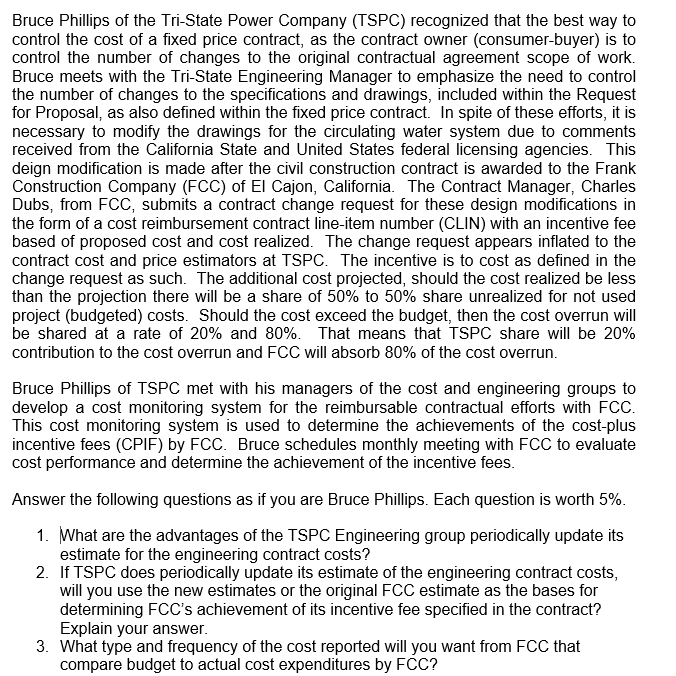
Bruce Phillips of the Tri-State Power Company (TSPC) recognized that the best way to control the cost of a fixed price contract, as the contract owner (consumer-buyer) is to control the number of changes to the original contractual agreement scope of work. Bruce meets with the Tri-State Engineering Manager to emphasize the need to control the number of changes to the specifications and drawings, included within the Request for Proposal, as also defined within the fixed price contract. In spite of these efforts, it is necessary to modify the drawings for the circulating water system due to comments received from the California State and United States federal licensing agencies. This deign modification is made after the civil construction contract is awarded to the Frank Construction Company (FCC) of El Cajon, California. The Contract Manager, Charles Dubs, from FCC, submits a contract change request for these design modifications in the form of a cost reimbursement contract line-item number (CLIN) with an incentive fee based of proposed cost and cost realized. The change request appears inflated to the contract cost and price estimators at TSPC. The incentive is to cost as defined in the change request as such. The additional cost projected, should the cost realized be less than the projection there will be a share of 50% to 50% share unrealized for not used project (budgeted) costs. Should the cost exceed the budget, then the cost overrun will be shared at a rate of 20% and 80%. That means that TSPC share will be 20% contribution to the cost overrun and FCC will absorb 80% of the cost overrun. Bruce Phillips of TSPC met with his managers of the cost and engineering groups to develop a cost monitoring system for the reimbursable contractual efforts with FCC. This cost monitoring system is used to determine the achievements of the cost-plus incentive fees (CPIF) by FCC. Bruce schedules monthly meeting with FCC to evaluate cost performance and determine the achievement of the incentive fees. Answer the following questions as if you are Bruce Phillips. Each question is worth 5%. 1. What are the advantages of the TSPC Engineering group periodically update its estimate for the engineering contract costs? 2. If TSPC does periodically update its estimate of the engineering contract costs, will you use the new estimates or the original FCC estimate as the bases for determining FCC's achievement of its incentive fee specified in the contract? Explain your answer. 3. What type and frequency of the cost reported will you want from FCC that compare budget to actual cost expenditures by FCC? Bruce Phillips of the Tri-State Power Company (TSPC) recognized that the best way to control the cost of a fixed price contract, as the contract owner (consumer-buyer) is to control the number of changes to the original contractual agreement scope of work. Bruce meets with the Tri-State Engineering Manager to emphasize the need to control the number of changes to the specifications and drawings, included within the Request for Proposal, as also defined within the fixed price contract. In spite of these efforts, it is necessary to modify the drawings for the circulating water system due to comments received from the California State and United States federal licensing agencies. This deign modification is made after the civil construction contract is awarded to the Frank Construction Company (FCC) of El Cajon, California. The Contract Manager, Charles Dubs, from FCC, submits a contract change request for these design modifications in the form of a cost reimbursement contract line-item number (CLIN) with an incentive fee based of proposed cost and cost realized. The change request appears inflated to the contract cost and price estimators at TSPC. The incentive is to cost as defined in the change request as such. The additional cost projected, should the cost realized be less than the projection there will be a share of 50% to 50% share unrealized for not used project (budgeted) costs. Should the cost exceed the budget, then the cost overrun will be shared at a rate of 20% and 80%. That means that TSPC share will be 20% contribution to the cost overrun and FCC will absorb 80% of the cost overrun. Bruce Phillips of TSPC met with his managers of the cost and engineering groups to develop a cost monitoring system for the reimbursable contractual efforts with FCC. This cost monitoring system is used to determine the achievements of the cost-plus incentive fees (CPIF) by FCC. Bruce schedules monthly meeting with FCC to evaluate cost performance and determine the achievement of the incentive fees. Answer the following questions as if you are Bruce Phillips. Each question is worth 5%. 1. What are the advantages of the TSPC Engineering group periodically update its estimate for the engineering contract costs? 2. If TSPC does periodically update its estimate of the engineering contract costs, will you use the new estimates or the original FCC estimate as the bases for determining FCC's achievement of its incentive fee specified in the contract? Explain your answer. 3. What type and frequency of the cost reported will you want from FCC that compare budget to actual cost expenditures by FCC







